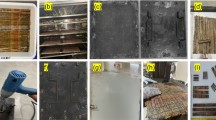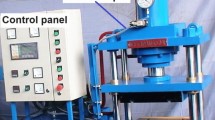Abstract
Hemp fibre-reinforced polyester composites were prepared using a Resin Transfer Moulding (RTM) technique and the flexural and impact behaviour investigated. Flexural stress at break and flexural modulus showed an increasing trend with fibre content. Impact strength was found to decrease at low fibre content, then gradually increase with further addition of fibres.
A strong interfacial adhesion between hemp and polyester was obtained using chemically modified hemp. This modification consisted in introducing reactive vinylic groups at the surface of the fibres, via esterification of hemp hydroxyl groups, using methacrylic anhydride. Increased bonding between fibres and matrix did not affect the flexural stress at break of the composite but was detrimental to toughness. This behaviour was ascribed to a change in the mode of failure, from fibre pull-out to fibre fracture, resulting in a marked reduction in the energy involved in the failure of the composite, leading to a more brittle material.
Similar content being viewed by others
References
White, N. M. and Ansell, M. P., 'Straw-reinforced Polyester Composites', J.Mater.Sci. 18, 1983, 1549.
Roe, P. J. and Ansell, M. P., 'Jute-reinforced Polyester Composites', J.Mater.Sci. 20, 1985, 4015.
Clark, R. A. and Ansell, M. P., 'Jute and Glass Fibre Hybrid Laminates', J.Mater.Sci. 21, 1986, 269.
Xian, X. J., Yipp, M. W., and Shin, F. G., Hybridized Bamboo Fiber Reinforced Composite Materials', in Proc.Int.Cong.Compas.Mater.10th, Whistler, BC 5, 1995, p. 259.
Singh, B. and Gupta, M., 'Hygrothermal Response of Polymer Composites Based on Modified Sisal Fibres and Unsaturated Polyester Resin', in Proc.Int.Conf.Compos.Mater.Energy, Montreal, 1995, p. 19.
Singh, B., Gupta, M., and Verma, A., 'Influence of Fibre Surface Treatment on the Properties of Sisal-Polyester Composites', Polym.Comp. 17(6), 1996, 910.
Devi, L. U., Bhagawan, S. S., and Thomas, S., 'Mechanical Properties of Pineapple Leaf Fiberreinforced Polyester Composites', J.Appl.Polym.Sci. 64(9), 1996, 1739.
Kessler, R. W. and Kohler, R., 'New Strategies for Exploiting Flax and Hemp', Chemtech. 26(12), 1996, 34.
Snell, R., Hague, J., and Groom, L., 'Characterizing Agrofibers for Use in Composite Materials', in Proc.Wood-fiber-Plastics Composites Symp., Forest Prod. Soc., Madisson, WI, 1997, p. 5.
O'Dell, J. L., 'Natural Fibers in Resin Transfer Molded Composites', in Proc.Wood-fiber-Plastics Composites Symp., Forest Prod. Soc., Madisson, WI, 1997, p. 280.
Beshay, A. D., Kokta, B. V., and Daneault, C., Polymer Comp. 6, 1985, 261.
Vick, C. B. and Rowell, R. M., Int.Adhesion and Adhesives 10, 1990, 2633.
Bledzki, A. K., Reihman, S., and Gassan, J., 'Properties and Modification Methods for Vegetable Fibers for Natural Fiber Composites', J.Appl.Polym.Sci. 59, 1996, 1329–1336.
Dinwoodie, J. M., Timber its Nature and Behaviour, Van Nostrand, New York, 1981, p. 132.
Cetin, N. S. and Hill, C. A. S., 'Surface Activation of Lignocellulosics by Chemical Modification', in Sec.Eur.Panel Prod.Symp., Llandudno, UK, 1998, p. 239.
Author information
Authors and Affiliations
Rights and permissions
About this article
Cite this article
Sèbe, G., Cetin, N.S., Hill, C.A.S. et al. RTM Hemp Fibre-Reinforced Polyester Composites. Applied Composite Materials 7, 341–349 (2000). https://doi.org/10.1023/A:1026538107200
Issue Date:
DOI: https://doi.org/10.1023/A:1026538107200




